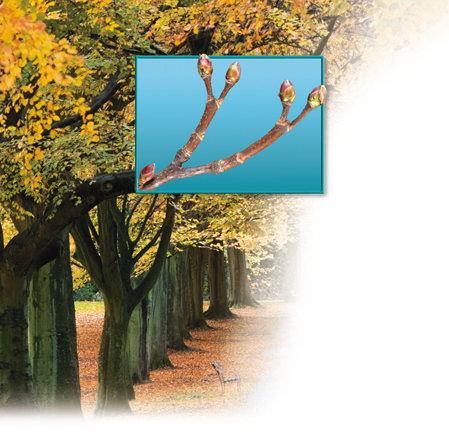Winter Dormancy Phytochrome also regulates the changes in activity that prepare many plants for dormancy as winter approaches. Recall that dormancy is the period during which an organism's growth and activity decrease or stop.  As cold weather approaches, deciduous plants turn off photosynthetic pathways, transport materials from leaves to roots, and seal off leaves from the rest of the plant.
As cold weather approaches, deciduous plants turn off photosynthetic pathways, transport materials from leaves to roots, and seal off leaves from the rest of the plant.
▸ Leaf Loss In temperate regions, many flowering plants lose their leaves during the colder months. At summer's end, the phytochrome in leaves absorbs less light as days shorten and nights become longer. Auxin production drops, but the production of ethylene increases. The change in the relative amounts of these two hormones starts a series of events that gradually shut down the leaf.
As chlorophyll breaks down, other pigments that have been present all along—including yellow and orange carotenoids—become visible for the first time. The brilliant reds come from freshly made antho-cyanin pigments.
▸ Changes to Meristems Hormones also produce important changes in apical meristems. Instead of continuing to produce leaves, meristems produce thick, waxy scales that form a protective layer around new leaf buds. Enclosed in its coat of scales, a terminal bud can survive the coldest winter days. At the onset of winter, xylem and phloem tissues pump themselves full of ions and organic compounds. The resulting solution acts like antifreeze in a car, preventing the tree's sap from freezing. This is one of several mechanisms plants use to survive the bitter cold.

FIGURE 24–20 Adaptations for Winter In autumn, leaves shut down photosynthesis and fall from deciduous trees. Meanwhile, meristems at the tips of the branches produce thick, waxy scales that cover and protect new stem and leaf buds through the harsh winter.
24.3 Assessment

-
Review Describe how plant hormones contribute to homeostasis.
Infer Why should a person who trims trees for a living know about the effect of apical dominance on the shape of trees? Explain.
-
Review Give three examples of plant responses to external stimuli.
Apply Concepts Using a houseplant, a marker, and a sunny windowsill, describe how you might measure the plant's response to light.
-
Review Summarize plant responses to seasonal changes.
Explain Which type of plant—short-day or long-day—is likely to bloom in the summer? Explain your answer.
c. Design an Experiment How could a garden-store owner determine what light conditions are needed for a particular flowering plant to bloom? Design a controlled experiment to find out.
Apply the Big idea
Review what you learned about evolution by natural selection in Chapter 16. Then, using what you know about natural selection, describe how plant adaptations for dormancy may have developed over time.

Table of Contents
- Formulas and Equations
- Applying Formulas and Equations
- Mean, Median, and Mode
- Estimation
- Using Measurements in Calculations
- Effects of Measurement Errors
- Accuracy
- Precision
- Comparing Accuracy and Precision
- Significant Figures
- Calculating With Significant Figures
- Scientific Notation
- Calculating With Scientific Notation
- Dimensional Analysis
- Applying Dimensional Analysis




